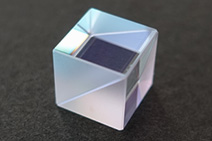Optical Contact Products

“Optical contact” is a glueless bonding process whereby two closely conformal surfaces of high precision prisms are joined together, being held purely by intermolecular forces. Our company makes a wide variety of optical contact products and polarizing beam splitters ranging from devices used in projectors, medical equipment to optical discs.
Optical contact polarizing beam splitters – their advantages
- Glue-less bonding – it means that it works even in ultra-violet and infrared ranges.
- Enhanced reliability in high-energy conditions using high-energy laser beams.
- Deterioration from wave aberration due to glue is unlikely to occur.
- Can be used in polarizing beam splitters, supporting wide-band wavelengths.
- Can be used in polarizing beam splitters with high extinction ratios.
- Can be used in polarizing beam splitters using optical glass materials that are insusceptible to stress due to heat (like PBH56 made by Ohara Optical Glass).
Fields demanding optical contact products
Medical equipment: Surgical laser devices and so on
Measuring instruments: Cell analyzers and so on
Aviation/space development: Survey and guiding systems and so on
Imaging: Projectors and so on
High precision polishing technology is essential for optical contact
“Optical contact”is a bonding process whereby two closely conformal surfaces of high precision prisms are joined together without using any glue, being held purely by intermolecular forces. Molecules existing inside prisms are pulling each other for maintaining stability, but molecules in the surfaces of precisely polished prisms are not joined together, staying in extremely unstable conditions (forming active surfaces). When those unstable prism surfaces are brought into contact, molecules on the prism surfaces interact each other, forming stable conditions like molecules inside the prisms. Cementing using these characteristics is called an optical contact process.
Naturally, a wide variety of knowhow is required in order to join prisms closely together, including technology for accelerating chemical reaction. With polishing technology in general, it is impossible to create highly accurate prism surfaces required for optical contact. We at Mitsui Optical worked hard on acquiring highly accurate polishing technology for decades, and are continuing to work hard on further.

Application fields of optical contact products
Advanced projectors and medical equipment using precision prism and optical disc products using blue laser are becoming popular more and more. Those laser products need bonded optical devices called “polarizing beam splitters”.
If optical components are joined together by using glue for making polarizing beam splitters, deterioration of optical performance due to deterioration of glue quality becomes a big problem. Therefore, such optical components cannot be used in optical systems for projectors used under extremely high luminous and humid conditions or in optical systems used for high output blue laser systems. In particular, if such prisms are used in devices using 405 nm laser, glue of those prims is damaged and deteriorate, causing image quality problems after some time lapse. Generally speaking, glue is durable up to 100 degrees centigrade. Products using light sources with high luminosity produce extreme heat so prism surfaces joined together with glue are separated. These phenomena are actually reported often, eventually shortening the life of optical systems. Optical contact technology using no glue becomes an essential technology for solving those problems.

Mitsui Optical’s cutting-edge technologies
“Ultra-high-precision prism polishing technology” and “ultra-high-performance thin-film coating technology” – these wo cutting-edge technologies we have clearly show our advantages over other optical device manufacturers.
- Glue-less bonding – it means that it works even in ultra-violet and infrared ranges.
- Enhanced reliability in high-energy conditions using high-energy laser beams.
- Deterioration from wave aberration due to glue is unlikely to occur.
- Can be used in polarizing beam splitters, supporting wide-band wavelengths.
- Can be used in polarizing beam splitters with high extinction ratios.
- Can be used in polarizing beam splitters using optical glass materials that are insusceptible to stress due to heat (like PBH56) made by Ohara.